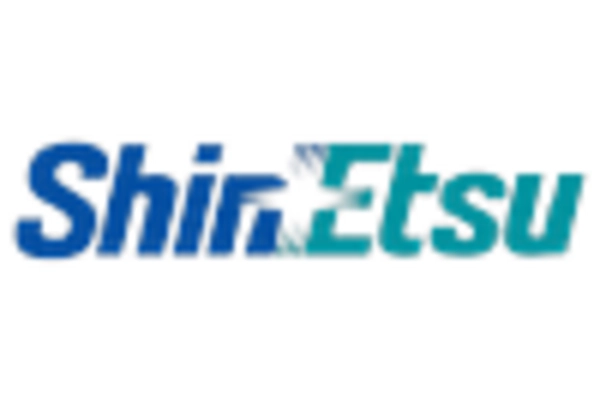Sustainability Initiatives
The increasing emphasis on sustainability within the textile industry appears to be a pivotal driver for the Silicone Textile Chemical Market. Manufacturers are increasingly adopting eco-friendly practices, which include the use of silicone-based chemicals that are less harmful to the environment compared to traditional options. This shift is likely to enhance the appeal of silicone textiles, as they offer durability and longevity, reducing waste. According to recent data, the market for sustainable textiles is projected to grow at a compound annual growth rate of approximately 9% over the next five years. This trend suggests that the Silicone Textile Chemical Market could see a corresponding increase in demand as brands seek to align with consumer preferences for environmentally responsible products.
Technological Advancements
Technological innovations in textile processing and chemical formulations are driving the Silicone Textile Chemical Market forward. The development of advanced silicone compounds that enhance fabric performance, such as water repellency, stain resistance, and UV protection, is becoming increasingly prevalent. These advancements not only improve the functionality of textiles but also expand their applications across various sectors, including fashion, automotive, and home furnishings. Market data indicates that the demand for high-performance textiles is expected to rise, with a projected increase of 7% annually. This growth suggests that the Silicone Textile Chemical Market is well-positioned to benefit from ongoing technological enhancements that cater to diverse consumer needs.
Expansion of the Apparel Sector
The expansion of the apparel sector is likely to serve as a catalyst for the Silicone Textile Chemical Market. With the rise of fast fashion and the increasing number of apparel brands entering the market, there is a growing need for innovative textile solutions that can meet diverse consumer demands. Silicone-based chemicals are favored for their versatility and ability to impart desirable qualities to fabrics, such as softness and elasticity. Market projections indicate that the apparel industry is set to grow at a rate of approximately 6% annually, which could translate into increased opportunities for the Silicone Textile Chemical Market as brands seek to differentiate their products through enhanced textile performance.
Rising Demand for Performance Fabrics
The growing consumer preference for performance fabrics is a significant driver for the Silicone Textile Chemical Market. As lifestyles become more active, there is an increasing demand for textiles that offer superior performance characteristics, such as moisture management, breathability, and durability. Silicone-based chemicals are particularly well-suited for these applications, as they enhance the functional properties of fabrics without compromising comfort. Recent market analysis indicates that the performance fabric segment is expected to witness a growth rate of around 8% over the next few years. This trend suggests that the Silicone Textile Chemical Market could experience heightened demand as manufacturers strive to meet the evolving expectations of consumers.
Regulatory Compliance and Safety Standards
The stringent regulatory landscape surrounding textile chemicals is influencing the Silicone Textile Chemical Market. As governments and regulatory bodies implement more rigorous safety standards, manufacturers are compelled to adopt safer alternatives, such as silicone-based chemicals, which are often perceived as less toxic. Compliance with these regulations not only ensures product safety but also enhances brand reputation among environmentally conscious consumers. Recent data suggests that the market for compliant textile chemicals is expected to grow by 5% annually. This trend indicates that the Silicone Textile Chemical Market may benefit from the increasing focus on regulatory compliance, as companies seek to align their products with safety and environmental standards.
















Leave a Comment